A 6-Step Blueprint to Achieving Social Media Success

You want a social content strategy that boosts awareness, traffic, and sales.
Social media is a fantastic way to meet customers where they’re at, thanks to its wealth of data and ability to reach a vast audience in a few clicks. But with its overcrowded landscape, how do you stand out and grow your following?
This guide walks you through the steps to sling-shot your brand out on social media, including how to track your progress on an automated reporting tool.
Skip right ahead:
- How Social Media Success Looks Like
- Why Track Social Media KPIs
- Our 6 Proven Steps to Achieve Social Media Success
- How to Create a Social Media Report Automatically on DashThis
- Social Media Success: Create Your Reports Automatically Today!
How Social Media Success Looks Like
Social media success takes on different shapes, from a SaaS founder’s viral LinkedIn post to a persuasive user-generated content that increases eCommerce sales.
Basically, it’s when you achieve your unique marketing or sales goals on all your social channels:
- Brand awareness: You have a strong social media presence. Your posts reach new and existing audiences, boosting brand awareness and recognition.
- Engagement: Your social content sees high engagement consistently. Posts often captivate attention and spark riveting discussions.
- Lead generation: There’s always a steady stream of new leads, thanks to on-point targeting and messaging and a fantastic product-market fit.
- Sales: It’s not only marketing. You’re also hitting your sales goals. Consumers love the content you post, so much so it compels them to click the buy button.
- Customer loyalty: You’ve hit the jackpot. You now have a community of loyal advocates who eagerly spread the word about your brand.
Why Track Social Media KPIs
Juggling multiple social media channels seamlessly is a challenge when time and resources are scarce.
Add the crowded content landscape to the mix and…well, it gets trickier.
That’s why you need to focus on the channels you’re most likely to succeed. By tracking your social media KPIs across these different platforms, you quickly identify what works and focus on the top-performers.
A deeper look at how tracking your social media KPIs lead to success
Evaluate performance - Regular KPI monitoring helps you gauge the overall impact of your social media marketing plan. You can quickly determine if you’re reaching the right audience, investing in the right content, and achieving your goals.
Optimize campaigns - Data never lies. You know how to improve your social media campaigns with zero guesswork.
Measure social ROI - Make the most of your marketing budget! By tracking your KPIs, you can easily weigh up how social media impact your overall digital marketing strategy and allocate resources accordingly.
Our 6 Proven Steps to Achieve Social Media Success
Considering a social media marketing strategy audit? This section walks you through the process from beginning to end.
Step 1: Set a goal using the SMART framework
Too many brands (and leaders) post on social media aimlessly.
Remember the big name CEO with a shirtless pic of him getting a massage? Yeesh.
These low effort posts without any strategic goals lead to underwhelming results. At best, a dozen likes and zero sales. At worst, negative publicity and damaged reputation.
So, what’s the best way to start on the right foot?
Set marketing goals that align with your broader business objectives.
Suppose you want to build a community of advocates to share your product on social media. Using the SMART framework, your goal will look like this:
“Increase brand’s social media followers by 30% within 10 months."
- Specific: 30% within 10 months
- Measurable: Track metrics like no. of followers, reach, impressions, and engagement rate in social analytics tools (or an automated reporting tool like DashThis)
- Attainable: The goal, a 30% increase in no. of followers, is achievable
- Relevant: More followers > more engagement + brand awareness and recognition (assuming you’re attracting the right audience)
- Time-bound: 10 months
It’s a simplified example, but you get the idea.
Treat your SMART goal as your north star.
It'll help you stay on track.
Step 2. Know your audience inside out
There are several ways to research customers, depending on the resources available.
Whether you're starting out with zero customers or looking to update your existing customer research, here's what we recommend:
- Identify ALL the sources that influence your target audience
- Participate in these sources to learn their struggles and desires
Start with audience research tools like SparkToro.
That way, you not only uncover their demographics but also the sources that influence them: the social networks they use and the YouTube channels, podcasts, and subreddits they follow.
Once you nail down these sources, read through the posts and comments.
Take note of:
- Goals - e.g., “I’m looking to gain weight and build muscle…”
- Struggles - e.g., “...unfortunately, I can’t go above X kg. I think my lack of appetite…”
- Memorable phrases - e.g., “I don’t just want to gain weight. I want to gain back my health, strength, and confidence.”
Summarize your findings in a buyer persona, detailing your audience's demographics, interests, behavior, and patterns and preferences.

Refer to this buyer persona before creating new content.
Better yet, share it with other customer-facing departments (e.g., sales, customer success). It’ll help everyone gain clarity on your most profitable customers and create a unified experience for them.
Step 3: Do better than your opponents
What you really want to do at this stage is to identify what works in the competition and brainstorm how you can do better.
Ask yourself the questions below:
- What social networks are your competitors on?
- How many accounts do they have on each platform? (note: some brands have more than one account on a single platform. SEMrush, for instances, has four on Instagram!)
- How do they promote their content? For example, do they drop a blog post's URL link on all social media platforms? Or do they adapt it to each specific platform? (e.g., tweetstorm on X, thought leadership quotes on Instagram, key takeaways on LinkedIn)
- What topics do they talk about? What contrarian view or unique POV can your brand adds to what's currently out there?
- How does their copy sound like? Is it quirky like Innocent Drinks? Sincere and empathetic like TOMS?
- What images do they use? Do they use stock photos, user-generated images, or their own photos?
- Where do the CTAs direct audience to?
- What hashtags do they use?
Don't stop at brands!
Consider reviewing the founders' and employees’ social media accounts.
With employees having 5x more reach than corporate accounts and their social followers 7x more likely to convert, odds are your competitors' employees are also posting on their own channels.
Step 4: Audit your channels
Evaluate your current social media performance after analyzing the competition.
Look at your:
- Performance metrics like impressions and reach, engagement, and top-performing posts. Watch out for patterns. What do the top posts have in common? Is it the format, topic, or the time they were posted?
- Content quality. Does your social media posts engage your audience and grow your brand? Are the social shorts driving followers to watch the full webinars? Which text posts are starting conversations? What about user-generated content—are they driving sales?
- Messaging. Brand messaging communicates your identity to the world. Check that all content reflects a similar tone of voice. Your positioning should also be clear, concise, and consistent across these channels.
- Social platforms efficiency. Review your social media workflow and identify the bottlenecks. What takes up most of your time? Is it when you publish content? Or when you manually track dozens of metrics across multiple social media profiles? How can you integrate your tools to optimize your workflow and gain back hours of your time?
Wrap up everything you've learned about your brand and competitors in a SWOT analysis.
Here's how it might look like for a fictional SEO software company that wants to start posting on TikTok:
- Strengths: "We can repurpose our top-performing Instagram reels and slice-and-dice webinar clips on TikTok."
- Weaknesses: "We have a modest budget. Plus, our one-person social media team is already busy with other channels."
- Opportunities: "We have an opportunity to reach a younger demographic."
- Threats: "Bigger competitors are already posting on TikTok, eating up our target audience's attention. There's also questions about the ban..."
Step 5: Create content that compels
And now, the fun part:
Creating quality content that compels your audience to take action (reminder: refer to your buyer persona when planning topics).
Au contrary, content doesn't always have to be how-to posts.
Consider these other types of content for a change:
- Behind-the-scenes to humanize your brand. For example, "A Day in the Life" video series and pictures of team-bonding activities to show the people behind your company.
- Personal updates from employees (e.g., who won a contest, who recently started a new hobby) to add a personal touch and emotional connection
- Unique quotes from internal employees and external subject matter experts to educate audience and improve authority in the field
- Polls to drive interest and engage target audience
- Questions around trends to kick-start conversations and showcase your unique POV
Note how CXL sparks a discussion on its LinkedIn page. The concept visual instantly grabs attention while the text makes a compelling case for hiring T-shaped marketers.
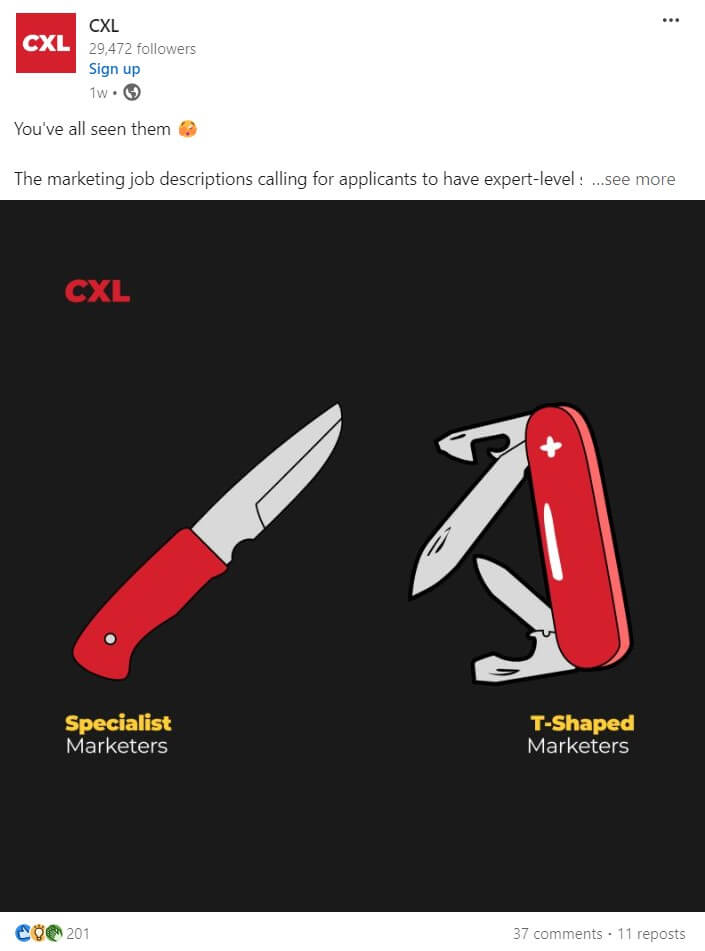
Pro tip: Repurpose your content to get more mileage from existing assets. Not only does this content strategy save time, but it also prevents the much dredged blank page syndrome.
That two-hour webinar you hosted last month?
Consider repurposing it to:
- Quote graphic images on Instagram
- Tactics on LinkedIn and Facebook
- Employees' insights on personal LinkedIn
- Tweetstorm on X and Threads
- Social shorts on Instagram, YouTube, and TikTok
You can also repurpose these content in other marketing channels: catchy one-liners in ad copies, contextual information in blog posts, and email courses.
Amplify your message to a wider audience.
Step 6: Monitor and refine
Finally, measure your social media performance.
Either track your results on individual social media analytics tools.
Or monitor your overall performance via an automated reporting tool like DashThis. Here's how it might look when you gather your entire data across different social media platforms into one report, automatically.
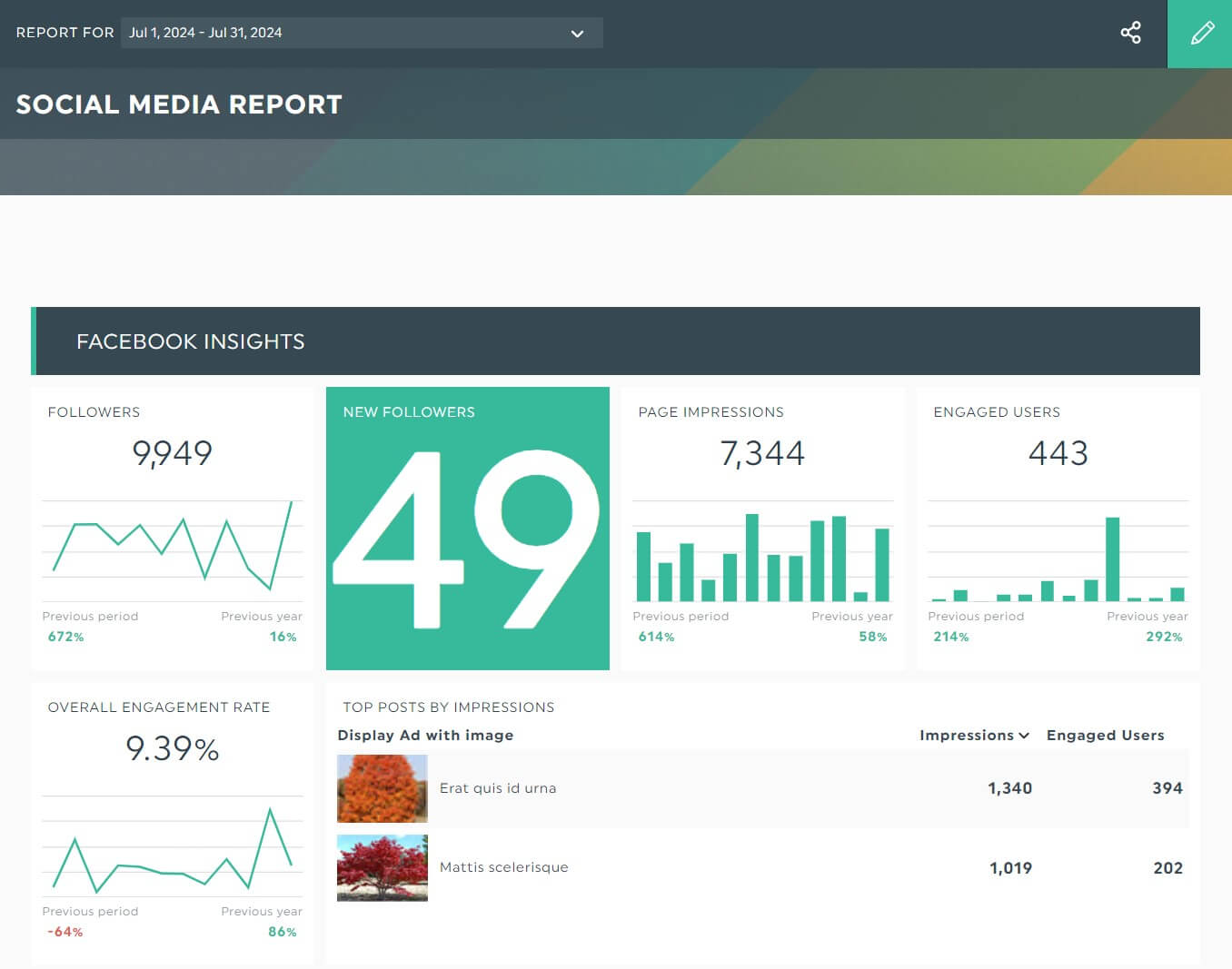
Grab this free social media report template with your own data!
Regularly monitor your social media KPIs.
Track engagement, impressions, and reach daily to see if your posts are reaching the right people. Monitor other metrics like number of new followers and conversion rates weekly—these tend to take time to generate results.
Next, refine your social media content according to your goal.
Let’s say your goal is increasing website traffic by 30% in Q4 this year.
Unfortunately, social engagement for your articles isn't performing as well as you hoped… Low engagement = low traffic.
As an experiment, you decide to tailor one article to each individual social media platform and tag marketing leaders for an even wider exposure.
- Instagram: Quote graphic visuals featuring marketing leaders
- X: Turn key takeaways into tweets
- LinkedIn: Pose the topic as a question (e.g., should you hire a T-shaped marketer or specialist?)
Measure if it impacts visibility and click-through traffic.
How to Create a Social Media Report Automatically on DashThis
DashThis is the easiest social media reporting tool.
Gather your entire social data into one beautiful report automatically. Whether it's Facebook, Instagram, YouTube, LinkedIn, or TikTok, our tool makes it ridiculously easy to analyze your overall social media marketing efforts in a single tab.
Here's how it works:
- Connect your favorite social media channels with DashThis
- Select a social media template
- Pick your social media metrics in Preset Widget
Wait a few seconds while DashThis auto-grabs the metrics you selected. Once they appear on the right side of the screen, drag and drop them to form a cohesive look.
Like this.
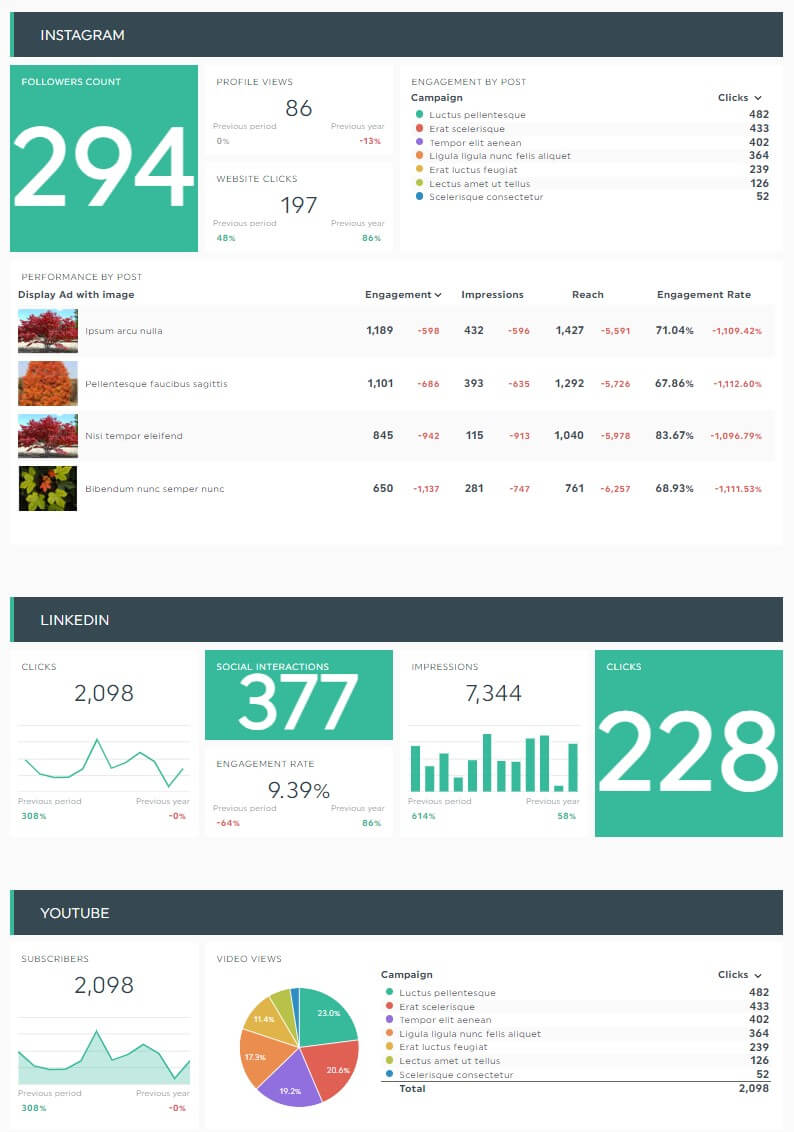
Customize the report.
Let’s imagine you want to make a case for the next social media strategy. Specifically: you want to convince a small business client to integrate it with their SEO content marketing strategy.
Our Comments widget is perfect for this.
Click Static Widget > Comment.
Explain what you have in mind.

Click Save.
Use the Notes widget if you want to provide context for erratic metrics or define marketing acronyms (e.g., CTR = click-through rate).
Hover to the metric and click Add Note.
Here’s how it looks on view mode. Once the orange tab is clicked, the note automatically appears on the right side of the screen.
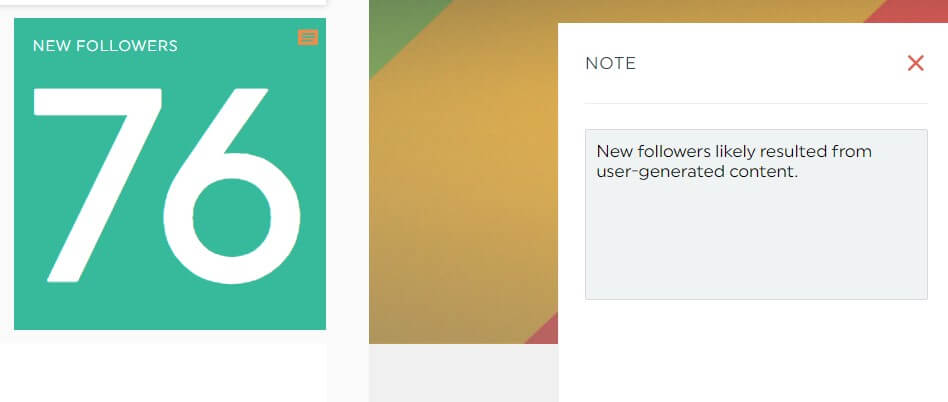
Once you’re done with the social media marketing campaign report, schedule an automatic email dispatch to all stakeholders:
- Hover to the Sharing Options icon on the top right
- Click Share by Email
- Set the dashboard period and frequency
- Click Schedule
This email dispatch sends your report according to your preferred schedule automatically.
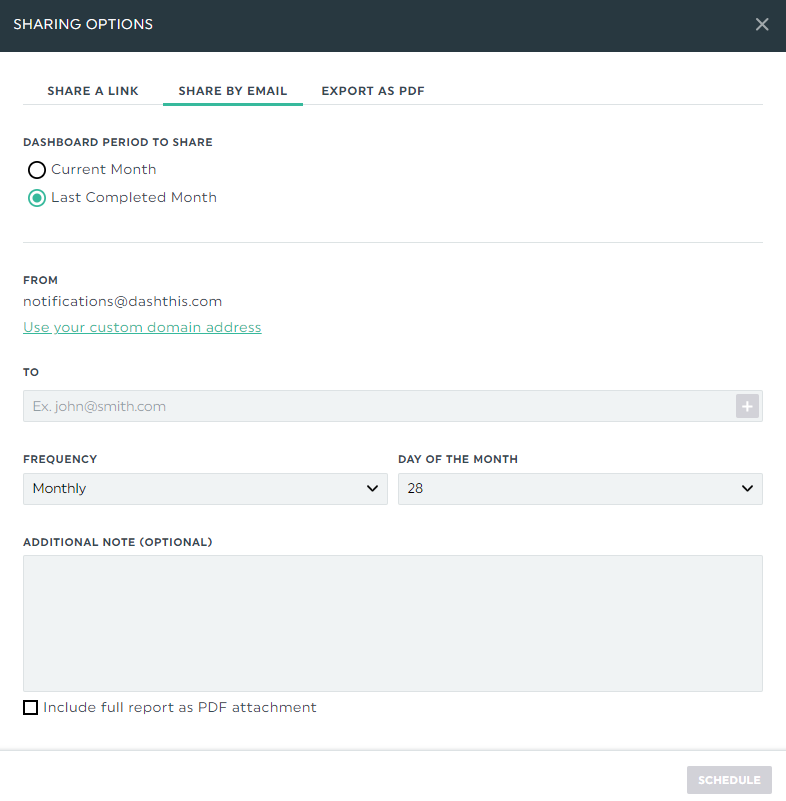
Or share it via a URL link.
Both options let you view results in real-time.
Start your free 15-day trial to automate your social media reports today.
Social Media Success: Create Your Reports Automatically Today!
From auditing your social strategy to refining it according to data, these steps show you how to sling-shot your brand forward on your favorite channels.
DashThis is the easiest social media reporting tool. Gather your entire data from your favorite social media management tools into one beautiful report, automatically.
Ready to track your social media success?
Read More
Don’t miss out!
Automate your reports!
Bring all your marketing data into one automated report.
Try dashthis for free

